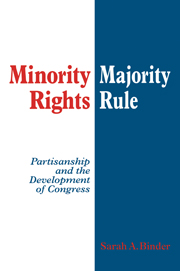Book contents
- Frontmatter
- Contents
- List of tables and figures
- Preface
- 1 The partisan basis of procedural choice
- 2 The evolving concepts of House and Senate minority rights
- 3 Procedural choice in the early Congress: The case of the “previous question”
- 4 Allocating minority rights in the House, 1789–1990
- 5 Institutionalizing party in the nineteenth-century House
- 6 Stacking the partisan deck in the twentieth-century House
- 7 Inherited rules and procedural choice in the Senate
- 8 Assessing the partisan theory
- Appendix 1 Summary of changes in minority rights
- Appendix 2 Measuring congressional workload
- Appendix 3 Measuring party behavior
- Bibliography
- Index
2 - The evolving concepts of House and Senate minority rights
Published online by Cambridge University Press: 10 December 2009
- Frontmatter
- Contents
- List of tables and figures
- Preface
- 1 The partisan basis of procedural choice
- 2 The evolving concepts of House and Senate minority rights
- 3 Procedural choice in the early Congress: The case of the “previous question”
- 4 Allocating minority rights in the House, 1789–1990
- 5 Institutionalizing party in the nineteenth-century House
- 6 Stacking the partisan deck in the twentieth-century House
- 7 Inherited rules and procedural choice in the Senate
- 8 Assessing the partisan theory
- Appendix 1 Summary of changes in minority rights
- Appendix 2 Measuring congressional workload
- Appendix 3 Measuring party behavior
- Bibliography
- Index
Summary
You cannot vest the minority with rights which the
majority do not enjoy and still keep it a minority.
For if the minority have rights which the majority
are denied, members would all hasten to join the mi-
nority, which would then become a majority and
lose at once its identity as a minority and its rights.
Representative William Cockran, 1909I look upon it as unnecessary and a gratuitous
wrong on our part to limit the rights of the minority
here. To-day I am with the majority on this floor;
next week I may not be. I have been in bodies where
I acted with minorities; and remembering the bene-
fits that I have received from rules securing the
rights of minorities I resolved then … that I would
never do anything, as a member of a legislative
body, tending to restrict or deprive the minority of
any rights I had enjoyed as a member of such body.
Representative Henry Dawes, 1874From the vantage point of William Cockran (D-New York), speaking on the House floor in 1909, there is something paradoxical – if not politically naive – about the idea of minority party rights. In a competitive political environment, it seems odd that a majority party would create attractive procedural rights for the minority, yet exclude itself from enjoying them. Indeed, from the perspective of Henry Dawes (R-Massachusetts) some thirty years earlier, majority parties would be wise to craft minority rights strategically.
- Type
- Chapter
- Information
- Minority Rights, Majority RulePartisanship and the Development of Congress, pp. 19 - 42Publisher: Cambridge University PressPrint publication year: 1997



